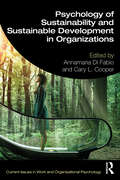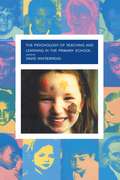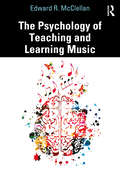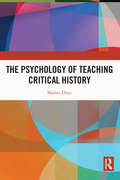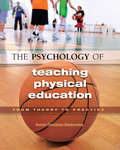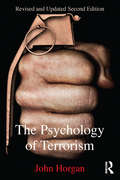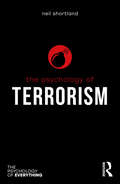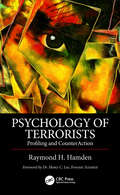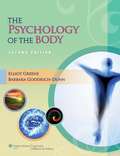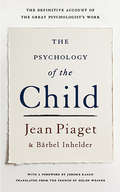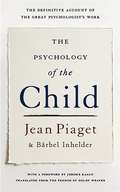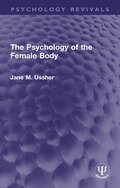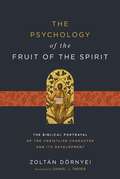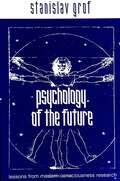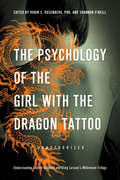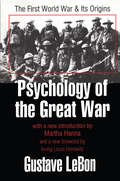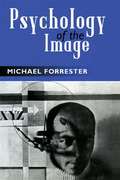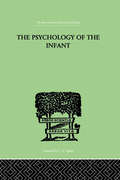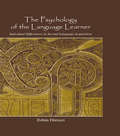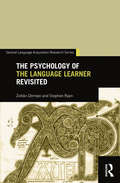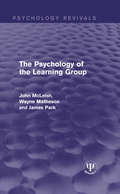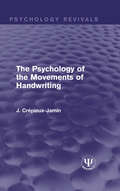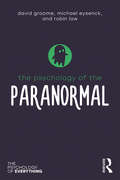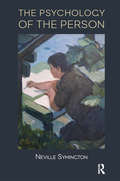- Table View
- List View
Psychology of Sustainability and Sustainable Development in Organizations
by Annamaria Di Fabio Cary L. CooperThis volume answers calls for improving sustainability and sustainable development in organizations from a psychological point of view. It offers a range of perspectives on the current research in the psychology of sustainability and sustainable development to highlight effective ways of improving well-being and healthy sustainable development in organizations. Section 1 introduces the concept of the psychology of sustainability and sustainable development as well as macro topics of related issues in organizations. Section 2 focuses on themes traditionally recognized in organizational psychology literature, such as performance, negotiation, leadership, resistance to change, innovation, and digital transformation. Section 3 presents variables to enhance sustainability and sustainable development in organizations and considers levels of prevention. Topics include humor awareness as a primary prevention resource in organizations, intrapreneurial self-capital as an individual preventative strength, compassion within organizations, perfectionism as an inhibitor in organizational contexts, and job crafting from individual to collaborative to organizational, meaningfulness and sustainable careers. With a clear psychological focus on the topic of leading sustainability efforts, this book will be of great interest to students and academics who want to learn more about corporate sustainability. It is also a useful resource for business executives, team leaders and managers.
The Psychology of Teaching and Learning in the Primary School
by David WhitebreadThis book reviews recent work in psychology which sheds new light on important areas of concern to primary school teachers, providing clear guidelines for good practice. The Psychology of Teaching and Learning in the Primary School details the current controversies regarding the effective teaching of reading and numeracy, how to deal with emotional and behavioural difficulties, the best methods of assessing learning, as well as teaching children to think and develop their creativity.It is a useful text for tutors and students on initial teacher training courses, and to teachers involved in professional development.Each chapter contains an editor's summary, a list of further reading, a full list of references and activities to develop and deepen the readers' understanding in each area. At the same time, the book is written in an accessible style ideal for the non-psychologist and is well illustrated with practical classroom examples.
The Psychology of Teaching and Learning Music
by Edward R. McClellanThe Psychology of Teaching and Learning Music introduces readers to the key theoretical principles, concepts, and research findings about learning and how these concepts and principles can be applied in the music classroom. Beginning with an overview of the study of teaching and learning, and moving through applying theory to practice, and reflective practice in the process of personal growth, this text focuses on music learning theories, behavioral approaches, cognitive, social-cognitive development, and constructive views of learning. It includes culture and community, learning differences, motivation, effective curricular design, assessment, and how to create learning environments, illustrated by practical case studies, projects, exercises, and photos. Showing students how to apply the psychology theory and research in practice as music educators, this book provides a valuable resource for undergraduate and graduate music education students and faculty.
The Psychology of Teaching Critical History
by Shalini DixitThis book delves into the psychology of teaching and learning history. It provides insight into the cognitive processes by which individuals imbibe history and how identity associations can shape our interpretation of histories. It assimilates concepts such as political scenario, curriculum, and pedagogy to give a holistic understanding of the processes involved in the learning of history. It discusses various themes such as the instrumentality of history in nation-building; psychological features and development of Historical Understanding; and the marginalisation of community history. It also provides suggestions on how teachers can reconcile with the developmental stages and multiple versions of history, while teaching tolerance and acceptance without compromising on nation-building commitments. An important contribution, this volume will be indispensable for students and researchers of education, history, psychology, and educational psychology. It will also be of interest to historians, teachers and teacher educators.
The Psychology of Teaching Physical Education: From Theory to Practice
by Bonnie BlankenshipThis book weaves together theory, research, and practical information related to the psychological aspects of physical education. Unlike other exercise/sport psychology books on the market, The Psychology of Teaching Physical Education is written especially for future and practicing physical educators and focuses on the psychological principles and strategies that are most relevant to them. The book covers the important topics of motivation, reinforcement, feedback, modeling, prosocial behaviors/moral development, and self-perception. In each chapter, narratives about real practicing teachers show how they apply the principles and theories of psychology to physical education, and particularly to actual situations that readers are likely to encounter professionally. Each chapter contains three main sections: following an opening scenario in which Blankenship captures the reader's attention with a real-life problem, the author then (1) highlights theories related to the subject matter of the chapter, (2) summarizes the research that has been conducted on the theories and the chapter topic, and (3) gives examples of practical applications of the theory and research to physical education. Throughout the chapter, as the theory, research, and application of the topic are discussed, Blankenship presents possible solutions to the challenge presented in the chapter-opening vignette. The classroom applications and real-world examples are relevant to many different physical education settings, including those at the elementary, middle, and high school levels, in both urban and rural schools representing various geographical regions of the country. These examples bring the theories to life and help readers envision how their own classes will benefit as they apply what theyÃve learned about the psychology of teaching physical education. Key Features of the Book A theory-to-research-to-practice approach. An author whose background in both sport psychology and physical education makes her uniquely qualified to write this book. Chapter-ending application exercises that encourage readers to go beyond rote memorization of concepts and principles to apply what they learned in various specific examples. Sample instructional models and guidelines to enable readers to incorporate concepts discussed in the chapter into their own classes. A comprehensive glossary.
The Psychology of Terrorism (Political Violence)
by John HorganThis new edition of John Horgan's critically acclaimed book is fully revised and expanded. The book presents a critical analysis of our existing knowledge and understanding of terrorist psychology. Despite the on-going search for a terrorist pathology, the most insightful and evidence-based research to date not only illustrates the lack of any identifiable psychopathology in terrorists, but demonstrates how frighteningly 'normal' and unremarkable in psychological terms are those who engage in terrorist activity. By producing a clearer map of the processes that impinge upon the individual terrorist, a different type of terrorist psychology emerges, one which has clearer implications for efforts at countering and disrupting violent extremism in today's world. In this 2nd edition, Horgan further develops his approach to the arc of terrorism by delving deeper into his IED model of Involvement, Engagement and Disengagement - the three phases of terrorism experienced by every single terrorist. Drawing on new and exciting research from the past decade, with new details from interviews with terrorists ranging from al-Qaeda to left-wing revolutionaries, biographies and autobiographies of former terrorists, and insights from historic and contemporary terrorist attacks since 2005, Horgan presents a fully revised and expanded edition of his signature text. This new edition of The Psychology of Terrorism will be essential reading for students of terrorism and political violence, and counterterrorism studies, and recommended for forensic psychology, criminology, international security and IR in general.
The Psychology of Terrorism (The Psychology of Everything)
by Neil ShortlandWhat is terrorism? Can anyone be radicalized? How can we respond to terrorist acts? The Psychology of Terrorism seeks to explain why some acts of violence are considered terrorism and others are not, and why some individuals may be more susceptible to engaging in radical terrorist behavior. Debunking myths and lazy stereotypes, the book delves into some of the most shocking atrocities of our times to discuss the complex and varied psychological characteristics of individual terrorists, organized groups, and their acts. Whilw there is no simple solution, The Psychology of Terrorism shows us that a growing reverse radicalization movement and modern interventionist techniques can give us hope for the future.
Psychology of Terrorists: Profiling and CounterAction
by Raymond H. HamdenThe Psychology of Terrorists examines the personality profile of the individual and categorizes the psychology of terrorists into four distinct profiles which are outlined and analyzed in detail. There are many books that cover social psychology and political violence and aggression, but few establish the mind-set of the terrorist as an individual. This includes taking into account personal experiences, and religious or political ideology for the purposes of understanding conceptual and tactical objectives and profiling terrorists to counter terrorist threats. <P><P>Dr. Raymond Hamden presents a unique look at terrorists as individuals with personal motives as well as those of principle. The book presents an analysis of terrorists without prejudice or bias for any political, religious, nationality, creed, or race. Too many times the world see experts focus on issues that are based on their own predispositions or partialities. Although there is criticism on the reliability of profiling, this research demonstrates validity and reliability. It is vital to understand terrorist motivations and this can only be achieved by "knowing" the terrorists' psychological character, looking at the individual terrorist, taking into account particular experiences, psychological makeup, background, and fundamentalist ideology. <P><P>The Psychology of Terrorists: Profiling and CounterAction will be a welcomed addition to psychologists, terrorism researchers, criminal profilers, investigators and intelligence professionals, counter- and anti-terrorism experts, as well as military, security, and law enforcement professionals tasked with protecting individuals from the various acts of terrorism, domestically and globally.
The Psychology of the Body (LWW Massage Therapy and Bodywork Educational Series)
by Elliot Greene Barbara Goodrich-DunnThe Psychology of the Body provides massage therapists, bodyworkers, and other professionals who use contact with the body with a greater understanding of the psychological issues that can arise from using touch in their therapy sessions. This new edition continues to provide a crucial basis of knowledge for students, recent grads, and experienced therapists alike regarding the emotional impact of effective therapy. The book describes the connection between the body and the mind, how touch affects this connection, the client's emotional reaction and release, and how to respond to the client in an appropriate manner. With a new, more colorful layout, this new edition has 50% more content and has been fully revised to address the latest science around this topic. For instructors, prepare your students to appropriately identify, understand, and respond appropriately to all aspects of the therapeutic relationship, including the phenomenon of emotional release, dealing with boundaries, effective interpersonal communications, and a body-based approach to ethics. Furthermore, in-text features aim to help students apply their learning to actual practice. Teaching resources like power point presentations, lesson plans, and tests with answer keys are available.
The Psychology Of The Child: Classification And Seriation (International Library Of Psychology Ser.)
by Jean Piaget Barbel InhelderThe definite account of psychologist Jean Piaget's work Jean Piaget's influence on psychology has been profound. His pathbreaking investigations and theories of cognitive development have set child psychology moving in entirely new directions. His bold speculations have provided the inspiration for the work of others. His studies have been the subject of many books and countless articles. And, significantly, his influence has spread to other disciplines and is having an ever-growing impact on the general culture at large.Here Jean Piaget, with the assistance of his long-time collaborator Bärbel Inhelder, offers a definitive presentation of the developmental psychology he has elaborated over the last forty years. This comprehensive synthesis traces each stage of the child's cognitive development, over the entire period of childhood, from infancy to adolescence.
The Psychology of the Child
by Jean Piaget Barbel InhelderPiaget’s influence on psychology has been profound. His pathbreaking investigations and theories of cognitive development have set child psychology moving in entirely new directions. His bold speculations have provided the inspiration for the work of others. His studies have been the subject of many books and countless articles. And, significantly, his influence has spread to other disciplines and is having an ever-growing impact on the general culture at large.Here Jean Piaget, with the assistance of his long-time collaborator Bärbel Inhelder, offers a definitive presentation of the developmental psychology he has elaborated over the last forty years. This comprehensive synthesis traces each stage of the child’s cognitive development, over the entire period of childhood, from infancy to adolescence.
The Psychology of the Female Body (Psychology Revivals)
by Jane M. UssherFirst published in 1989, The Psychology of the Female Body examines the role of the female body in women’s identity and experience. She discusses how key events such as menarche, menstruation, pregnancy, and the menopause affect women’s lives, and looks at the ways in which the female body and reproduction have been used to confine and control women. She puts forward psychological evidence to refute many of the myths surrounding women’s bodies, highlighting how empirical evidence shows that, contrary to what stereotypes suggest, women are not victims of their biology. This book will be of interest to students of psychology, sociology, gender studies and women’s studies.
The Psychology of the Fruit of the Spirit: The Biblical Portrayal of the Christlike Character and Its Development
by Zoltán DörnyeiFor centuries, the fruit of the Spirit has rightfully served as a wellspring of reflection on the virtues that epitomize the Christian life and character-building. However, the notion of the fruit of the Spirit is not limited solely to forming the biblical foundation of ethical living.Psychologist and theologian Zoltán Dörnyei argues that if we understand the nine attributes collectively as a concise portrayal of the ideal Christian self, this approach places the notion of the fruit of the Spirit at the intersection of several important theological themes, such as being conformed to the divine image, the gradual advancement of the kingdom of God, and new creation. In The Psychology of the Fruit of the Spirit, Dörnyei offers a scholarly exposition of the relevant theological content associated with the fruit of the Spirit. Complementing his theological reflections with findings from the field of psychology, he brings expertise in both psychology and theology to bear on this important biblical concept. His integrated perspective helps to uncover the full meaning and theological potential of the fruit of the Spirit by helping to clarify the nature of its nine facets, defining broader psychological dimensions that underlie the fruit, and offering practical lessons for cultivating it in the Christian life.
Psychology of the Future: Lessons from Modern Consciousness Research (SUNY series in Transpersonal and Humanistic Psychology)
by Stanislav GrofSummarizes Grof's experiences and observations from more than forty years of research into non-ordinary states of consciousness.This accessible and comprehensive overview of the work of Stanislav Grof, one of the founders of transpersonal psychology, was specifically written to acquaint newcomers with his work. Serving as a summation of his career and previous works, this entirely new book is the source to introduce Grof's enormous contributions to the fields of psychiatry and psychology, especially his central concept of holotropic experience, where holotropic signifies "moving toward wholeness." Grof maintains that the current basic assumptions and concepts of psychology and psychiatry require a radical revision based on the intensive and systematic research of holotropic experience. He suggests that a radical inner transformation of humanity and a rise to a higher level of consciousness might be humankind's only real hope for the future."It's rare to find a textbook that is both extremely informative and enjoyable to read. Psychology of the Future has to be one of the first ones I've ever come across … Each chapter brought an entirely new concept, theory, or method that was just as engaging as the previous one." — Dr. Tami Brady, TCM Reviews"This book is by a pioneering genius in consciousness research. It presents the full spectrum of Grof's ideas, from his earliest mappings of using LSD psychotherapy, to his clinical work with people facing death, to his more recent work with holotropic breathing, to his latest thoughts about the cosmological implications of consciousness research and the prospects for dealing with an emerging planetary crisis. Grof has always been one of the most original thinkers in the transpersonal field, and his creativity has kept pace with the maturity of his overall vision." -- Michael Washburn, author of Transpersonal Psychology in Psychoanalytic Perspective"Grof offers an outstanding contribution to the ever-growing debate about the nature of human consciousness and about the place of humankind in the cosmos. If more psychiatrists could be persuaded that human consciousness transcends the limitations of the physical brain, and instead is but an aspect of what may best be described as 'cosmic consciousness,' we could not only expect treatment modalities to change, but we could also anticipate the possibility of culture-wide rethinking of the basic presuppositions of modern cosmology, the cosmology that grounds Western institutions, ideologies, and beliefs about the nature of personhood." -- Michael E. Zimmerman, author of Contesting Earth's Future: Radical Ecology and PostmodernityStanislav Grof, MD, is a psychiatrist with more than fifty years of experience in research of non-ordinary states of consciousness. He has been Principal Investigator in a psychedelic research program at the Psychiatric Research Institute in Prague, Czechoslovakia; Chief of Psychiatric Research at the Maryland Psychiatric Research Center; Assistant Professor of Psychiatry at the Johns Hopkins University; and Scholar-in-Residence at the Esalen Institute. He is currently Professor of Psychology at the California Institute of Integral Studies, conducts professional training programs in holotropic breathwork, and gives lectures and seminars worldwide. He is one of the founders and chief theoreticians of transpersonal psychology and the founding president of the International Transpersonal Association (ITA). In 2007, he was granted the prestigious Vision 97 award from the Vaclav and Dagmar Havel Foundation in Prague. He is the author and editor of many books, including The Adventure of Self-Discovery: Dimensions of Consciousness and New Perspectives in Psychotherapy and Inner Exploration; Ancient Wisdom and Modern Science; Beyond the Brain: Birth, Death, and Transcendence in Psychotherapy; The Cosmic Game: Explorations of the Frontiers of Human Consciousness; and Human Survival and Consciousness Evolution; all published by SUNY Press.
The Psychology of the Girl with the Dragon Tattoo: Understanding Lisbeth Salander and Stieg Larsson's Millennium Trilogy
by Lynne McDonald-SmithLisbeth Salander, heroine of Stieg Larsson's The Girl with the Dragon Tattoo and its sequels, is one of the most compelling, complex characters of our time. Is she an avenging angel? A dangerous outlaw? What makes Salander tick, and why is our response to her-and to Larsson's Millennium trilogy-so strong?In The Psychology of the Girl with the Dragon Tattoo, 19 psychologists and psychiatrists attempt to do what even expert investigator Mikael Blomkvist could not: understand Lisbeth Salander. What does Lisbeth's infamous dragon tattoo really say about her? Why is Lisbeth so drawn to Mikael, and what would they both need to do to make a relationship work? How do we explain men like Martin Vanger, Nils Bjurman, and Alexander Zalachenko? Is Lisbeth just as sexist and as psychopathic as they are? What is it about Lisbeth that allows her to survive, even thrive, under extraordinary conditions? How is Lisbeth like a Goth-punk Rorschach test? And what do we learn about ourselves from what we see in her?
Psychology of the Great War: The First World War and Its Origins
by Shayne C. Gad Carrol S. WeilThe outbreak of World War I saw the collapse of socialist notions of class solidarity and reaffirmed the enduring strength of nationalism. The workers of the world did not unite, but turned on one another and slaughtered their fellows in what was then the bloodiest war in history. There have been many efforts to explain the outbreak of war in 1914, but few from so intimate a perspective as LeBon's. He examines such questions as why German scholars tried to deny Germany's obvious guilt in the war, and what explained the remarkable resolve of the French army to persevere in the face of unprecedented adversity.To such questions, LeBon proposes answers built upon principles well articulated in the larger body of his work. He transforms the character of the debate by demonstrating how psychological principles explain more persuasively both the causes of German academic ignominy and the origins of French valor. Convinced as he was that only psychology could illuminate collective behavior, LeBon dismisses purely economic or political interpretations as ill-conceived and inadequate precisely because they fail to appreciate the role of psychology in the collective behavior of national statesmen, prominent scholars, and ordinary soldiers.The Psychology of the Great War provides a bridge to study both crowd behavior and battlefield behavior by illustrating how ordinary people are transformed into savages by great events. This element in LeBon's thinking influenced Georges Sorel's thinking, as he had seen the same phenomenon in those who participated in general strikes and revolutions. And in a later period and different context, Hannah Arendt gave this strange capacity of the ordinary to be transformed into the extraordinary the name "banality of evil." The book will be of interest to social theorists, psychologists concerned with group behavior, and historians of the period.
The Psychology of the Human-Animal Bond
by Güler Boyra Christopher Blazina David Shen-MillerThere have been dramatic increases in the financial, emotional, and psychological investment in pets over the past four decades. The increasing importance of animal companions in people's lives has resulted in growing emphasis on the human-animal bond within academic literature. This book introduces practicing and emerging professionals to vital subject matter concerning this growing specialty area by providing an essential framework and information through which to consider the unique contextual backdrop of the human-animal bond. Such contexts include a wide array of themes including: issues of attachment and loss, success and frustration with making and sustaining connections, world views regarding animal ethics, familial history of neglect or abuse, and cultural dynamics that speak to the order of things between mankind and nature. Adopting a contextual stance will aid mental health professionals in appreciating why and how this connection has become a significant part of everyday life for many. As with any other important clinical dynamic, training and preparation are needed to gain competence for professional practice and research. To this end, an ensemble of international experts across the fields of psychology and mental health explore topics that will help both new and established clinicians increase and understanding of the various ways the human-animal bond manifests itself. Perspectives from beyond the scope of psychology and mental health such as anthropology, philosophy, literature, religion, and history are included to provide a sampling of the significant contexts in which the human-animal bond is established. What brings these divergent topics together in a meaningful way is their relevance and centrality to the contextual bonds that underlie the human-animal connection. This text will be a valuable resource that provides opportunities to deepen one's expertise in understanding the psychology of the human-animal bond.
Psychology of the Image (Psychology Press And Routledge Classic Editions Ser.)
by Michael ForresterPsychology of the Image outlines a theoretical framework bringing together the semiotic concepts developed by Charles Peirce, the sociological insights of Ervin Goffman and the psychoanalytic ideas of Jacques Lacan. Image studies in fashion, advertising, photography, film studies and psychology have been influenced by these theorists in significant ways. The framework presented helps the reader understand how these ideas relate to the study of different domains of the image: the internal imagery of dreams, external images such as the photograph and image processes which span both contexts, e.g., images we have about ourselves. The topics discussed are organised into three themes. The first considers mental imagery, including sound and dreams. The second addresses the interdependent nature of internal and external images, e.g., the gendered self and social identity. In the third theme, attention turns to external images including television, film, photography, the computer and the internet. Psychology of the Image will be of interest to undergraduates, postgraduates, lecturers and researchers in the fields of psychology, media studies and sociology.
The PSYCHOLOGY OF THE INFANT (International Library Of Psychology Ser. #Vol. 2)
by Bernfeld, SiegfriedFirst Published in 1999. Routledge is an imprint of Taylor & Francis, an informa company.
The Psychology of the Language Learner: Individual Differences in Second Language Acquisition (Second Language Acquisition Research Series)
by Zoltán DörnyeiResearch results over the past decades have consistently demonstrated that a key reason why many second language learners fail--while some learners do better with less effort--lies in various learner attributes such as personality traits, motivation, or language aptitude. In psychology, these attributes have traditionally been called "individual differences." The scope of individual learner differences is broad--ranging from creativity to learner styles and anxiety--yet there is no current, comprehensive, and unified volume that provides an overview of the considerable amount of research conducted on various language learner differences, until now.Each chapter in this new volume focuses on a different individual difference variable. Besides a review of the relevant second language literature, Zoltán Dörnyei presents a concise overview of the psychological research involving each topic. A key concern for the author has been to define the various learner factors as measurable constructs and therefore the discussion includes a summary of the most famous tests and questionnaires in each domain.A wide range of readers will benefit from this book--students in linguistics, applied linguistics, modern languages, and psychology programs; second language teachers participating in in-service training courses; and researchers in second language acquisition and psychology.
The Psychology of the Language Learner Revisited (Second Language Acquisition Research Series)
by Zoltan Dornyei Stephen RyanOver the past decade, the focus of inquiry into the psychology of SLA has shifted from the analysis of various characteristics within individuals towards a greater consideration of individuals’ dynamic interactions with diverse contexts. This revisit of the bestselling The Psychology of the Language Learner reflects on these developments by challenging some of the assumptions upon which the original text was based, maintaining the familiar structure of the original, while situating the discussion within a very different theoretical framework. Written in a lively, accessible style, the book considers how the field has evolved and maintains a keen eye on the future, suggesting exciting new directions for the psychology of SLA. The Psychology of the Language Learner Revisited will appeal to students and researchers in a wide range of disciplines, including applied linguistics, second language acquisition, modern languages, and psychology.
The Psychology of the Learning Group (Psychology Revivals)
by John McLeish Wayne Matheson James ParkOriginally published in 1973, this work takes a hard look at the claims made for the small group as a learning medium (lecture, structured discussion, ‘sensitivity’, training groups etc.). Various theories of group dynamics, leadership function and learning process are looked at critically on the basis of actual research findings. It was intended for students of social psychology and anyone teaching or training to teach at Further Education level at the time, and will still be of interest in its historical context today.
The Psychology of the Movements of Handwriting (Psychology Revivals)
by J. Crepieux-JaminOriginally published in 1926, this title is a summary in English of the works of the great French graphologist Jules Crépieux-Jamin. He was recognised at the time in France as the first authority on the subject of graphology, but was less well-known in England and America. This title brought his work to the English speaking world and he went on to be known as one of the most important exponents of graphology.
The Psychology of the Paranormal (The Psychology of Everything)
by David Groome Michael Eysenck Robin LawCan mediums communicate with the dead? Do people really believe they’ve been abducted by aliens? Why do some people make life decisions based on their horoscope? The Psychology of the Paranormal explores some commonly held beliefs regarding experiences so strange they can defy an obvious scientific explanation. The book explains how psychologists have conducted experiments to provide insight into phenomena such as clairvoyance, astrology, and alien abduction, as well as teaching us fundamental truths about human belief systems. From debunking myths about Extra Sensory Perception, to considering whether our lives can truly be fated by the stars, The Psychology of the Paranormal shows us that however unlikely, belief in the paranormal will continue to be widespread.
The Psychology of the Person
by Neville SymingtonThis new title, from a distinguished psychoanalyst, will inspire both those in the psychoanalytic field, and the general reader.'In this book the author attempts to sketch out a "Psychology of the Person". The definition of "person" implies that no two people, even identical twins, are the same. Although this is obvious and no sensible person would quarrel with such a view, yet many terms are used that imply that there is a sameness between two or more people. For instance, it is often said that one individual is identified with another which, in ordinary language, means that he or she makes him or herself the same as the other, yet this is an impossibility. So, what is a person? How is a person different from someone who is not a person? This book sets out to answer these questions.
